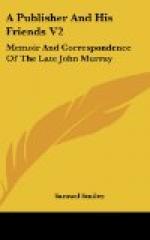Mr. Blackwood then proceeds to give an account of the Introduction, the commencement of “The Black Dwarf,” the first of the tales, and the general nature of the story, to the end of the fourth chapter. His letter is of great length, and extends to nine quarto pages. He concludes:
“There cannot be a doubt as to the splendid merit of the work. It would never have done to have hesitated and higgled about seeing more volumes. In the note which accompanied the sheets, Ballantyne says, ’each volume contains a Tale,’ so there will be four in all. [Footnote: This, the original intention, was departed from.] The next relates to the period of the Covenanters. I have now neither doubts nor fears with regard to the whole being good, and I anxiously hope that you will have as little. I am so happy at the fortunate termination of all my pains and anxieties, that I cannot be in bad humour with you for not writing me two lines in answer to my last letters. I hope I shall hear from you to-morrow; but I entreat of you to write me in course of post, as I wish to hear from you before I leave this [for London], which I intend to do on this day se’nnight by the smack.”
At length the principal part of the manuscript of the novel was in the press, and, as both the author and the printer were in sore straits for money, they became importunate on Blackwood and Murray for payment on account. They had taken Ballantyne’s “wretched stock” of books, as Blackwood styled them, and Lockhart, in his “Life of Scott,” infers that Murray had consented to anticipate the period of his payments. At all events, he finds in a letter of Scott’s, written in August, these words to John Ballantyne: “Dear John,—I have the pleasure to enclose Murray’s acceptances. I earnestly recommend you to push, realising as much as you can.
“Consider weel, gude mon,
We hae but borrowed gear,
The horse that I ride on,
It is John Murray’s mear.”
Scott was at this time sorely pressed for ready money. He was buying one piece of land after another, usually at exorbitant prices, and having already increased the estate of Abbotsford from 150 to nearly 1,000 acres, he was in communication with Mr. Edward Blore as to the erection of a dwelling adjacent to the cottage, at a point facing the Tweed. This house grew and expanded, until it became the spacious mansion of Abbotsford. The Ballantynes also were ravenous for more money; but they could get nothing from Blackwood and Murray before the promised work was finished.
At last the book was completed, printed, and published on December 1, 1816; but without the magical words, “by the Author of ‘Waverley,’” on the title-page. All doubts as to the work being by the author of “Waverley,” says Lockhart, had worn themselves out before the lapse of a week.
John Murray to Mr. Wm. Blackwood.
December 13, 1816.




